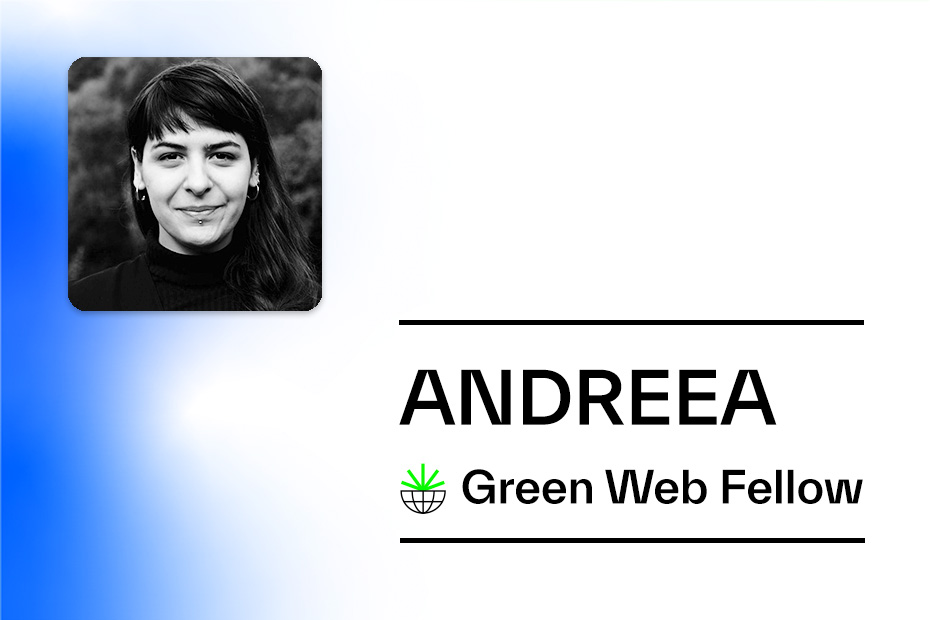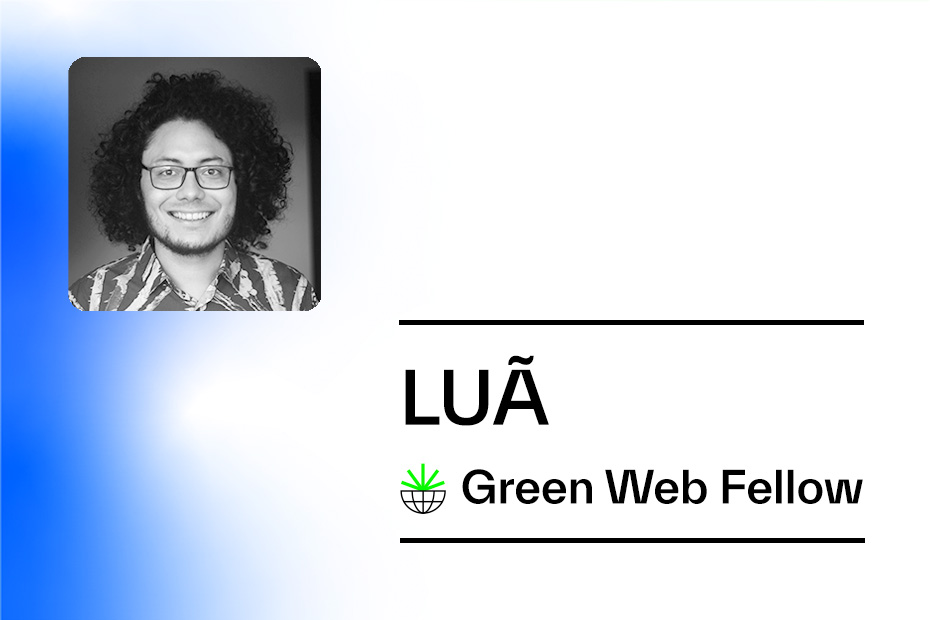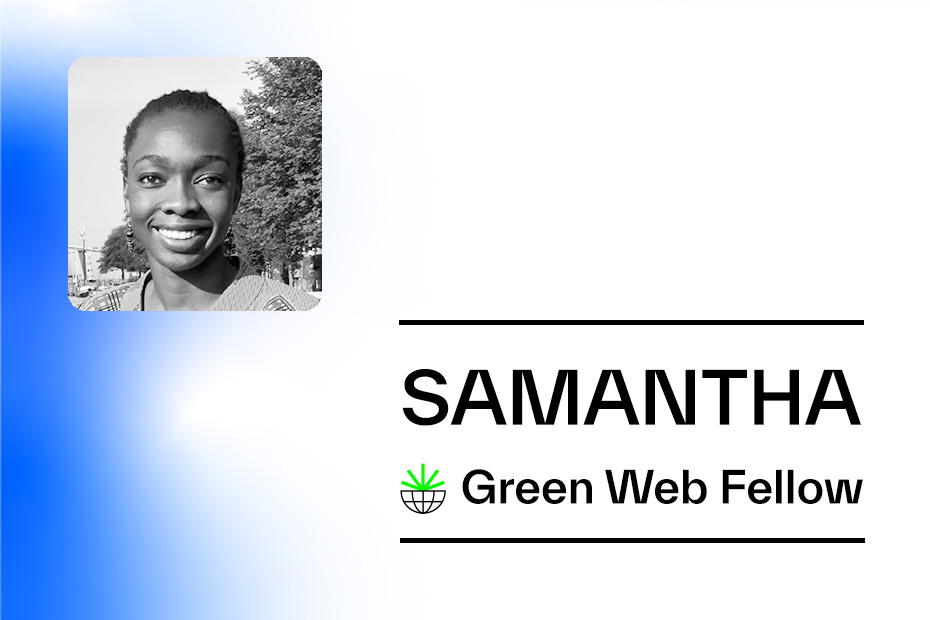Dear diary,
One of the things we were asked to do on the fellowship was to find something of interest to us and go off to explore it. A project of sorts. A very exciting prospect but also quite a terrifying one when you consider the broadness of both digital technology and climate justice.
We were asked to put together some ideas at the beginning of Jan 2022, for sharing with the rest of the fellows. At the time I was thinking about a campaign I’d run previously called #LetsGreenTheWeb, and had recently written a post “Reframing the #LetsGreenTheWeb campaign in a climate justice context” with some thoughts. Using this, I put together a presentation for my project around the idea of running #LetsGreenTheWeb in 2022.
My key idea was to recycle the #LetsGreenTheWeb 2021 campaign methods. This would help find and engage our target audience. Then I could make workshops available to those interested into a deeper understanding of how climate justice principles relate to websites and how they could identify suitable actions.
Cool. So just need a workshop and we’re sorted.
I set out some goals for myself and considered a few questions like who is the audience, what do I want participants to feel, what do I want them to learn and what I needed the workshop materials I developed to be like. A good starting point to work from.
At the bottom of this goals doc, you’ll see I started to sketch out a workshop format. But after thinking this through for a while I didn’t really like the direction. I realised I was relying on the concepts of “social foundations” and “ecological ceilings” from Doughnut Economics too much. Most people would probably have no idea what these meant. I talked about Doughnut Economics in some of my earlier posts when I was first learning about climate justice.
That’s when I decided to change tack.
Instead of thinking about this as an output of another #LetsGreenTheWeb campaign, how about I slim this down. Wouldn’t this be a great opportunity to explore the fabulous concepts in Doughnut Economics a little more deeply? That in itself is a meaty project in its own right! Perhaps another version of #LetsGreenTheWeb can happen another time?
My project became “Can Doughnut Economics be used as a holistic way of exploring the digital tech sector’s impact on global sustainability?”.
In some ways it was a relief to not worry about the campaign. In some other ways I found myself staring down the barrel of another enormous challenge. How on earth do I go about this?
Designing the workshop
After a lot more research around Doughnut Economics, and especially on the Doughnut Economics Action Lab, I came across the Creating City Portraits guide and drew a whole ton of inspiration from there.
A City Portrait takes a holistic snapshot of a city’s performance across four crucial ‘lenses’ that arise from combining two domains (social and ecological) and two scales (local and global).
The four lenses become:
- LOCAL / SOCIAL
- LOCAL / ECOLOGICAL
- GLOBAL / SOCIAL
- GLOBAL / ECOLOGICAL
Each of these interconnected lenses focus on a part of the overarching question at the core of the City Portrait. Together, they combine local aspirations – to be thriving people in a thriving place – with global responsibility – both social and ecological – and require every place to consider its many complex interconnections with the world in which it is embedded.
But instead of regarding a place, I wanted to think about an industry: the digital tech industry.
I began designing the workshop and came up with three core questions that I thought would be valuable to explore.
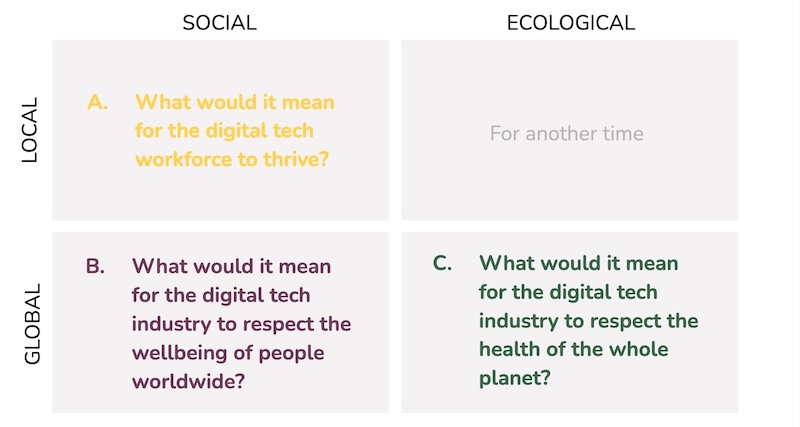
The questions became:
- LOCAL/SOCIAL: What would it mean for the digital tech workforce to thrive?
- GLOBAL/SOCIAL: What would it mean for the digital tech industry to respect the wellbeing of people worldwide?
- GLOBAL/ECOLOGICAL: What would it mean for the digital tech industry to respect the health of the whole planet?
Armed with the outline of a workshop my next big question, “who in their right minds will spend time exploring these questions with me? It’s kind of a big ask” 🤔
Cue the fantastic ClimateAction.tech community. I put together a short doc explaining my ideas and asked for willing volunteers in their Slack group. I got a good response and 29 people were kind/mad enough to give it a go. Fortune favours the brave right?
Another happy outcome, I also connected with Alistair Alexander, who was also keen to explore Doughnut Economics in this way and he agreed to co-facilitate the workshops and help analyse the findings.
The final format
The workshops were 2.5 hours each and designed for between 6 and 10 participants, with 2 facilitators.
It started with a round of introductions between the attendees which provided a good chance for people to get to know each other, and do a little light networking. The main part of the workshop split attendees into two groups and asked them to explore the lenses using a Miro board to facilitate the session. Each of the lenses encouraged attendees to explore the pains they see in each of the dimensions, and ideas or vision for changing that in the future.
Lens A: What would it mean for the digital technology workforce to thrive?
LOCAL/SOCIAL
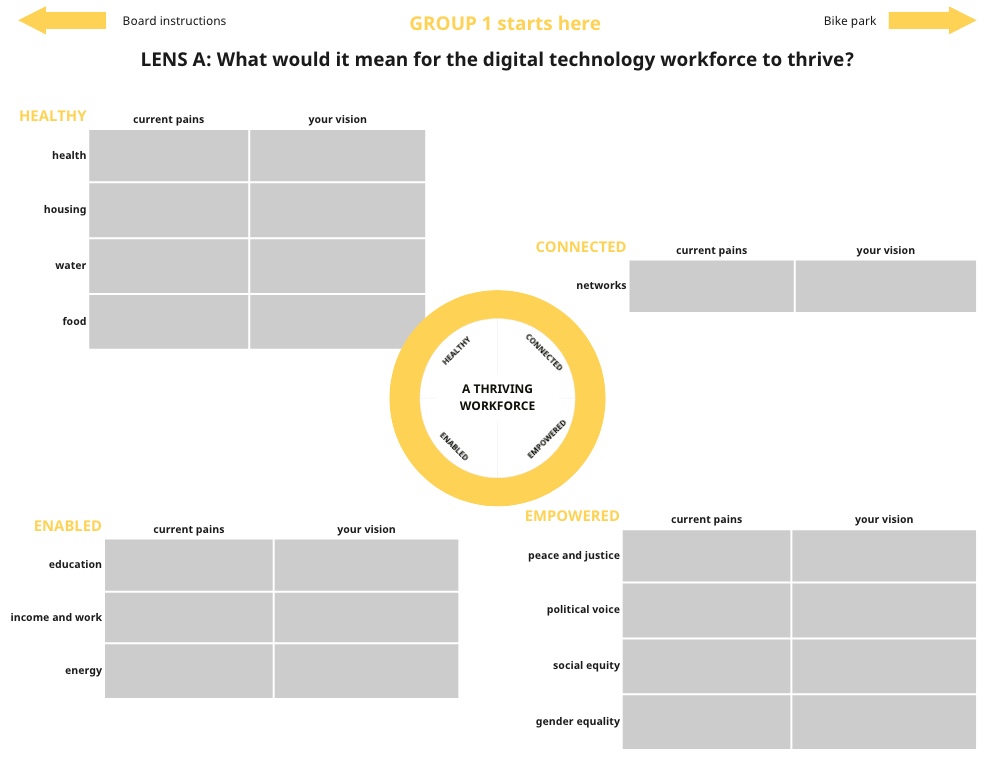
Lens B: What would it mean for the digital technology workforce to thrive?
GLOBAL/SOCIAL
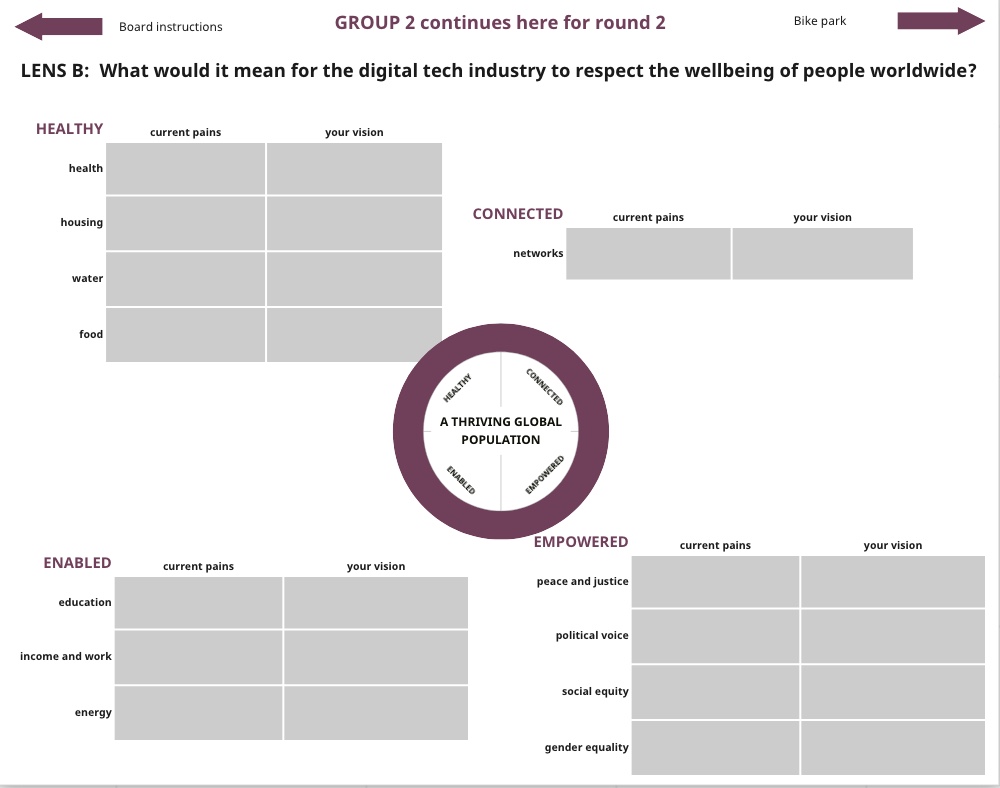
Lens C: What would it mean for the digital tech industry to respect the health of the whole planet?
GLOBAL/ECOLOGICAL
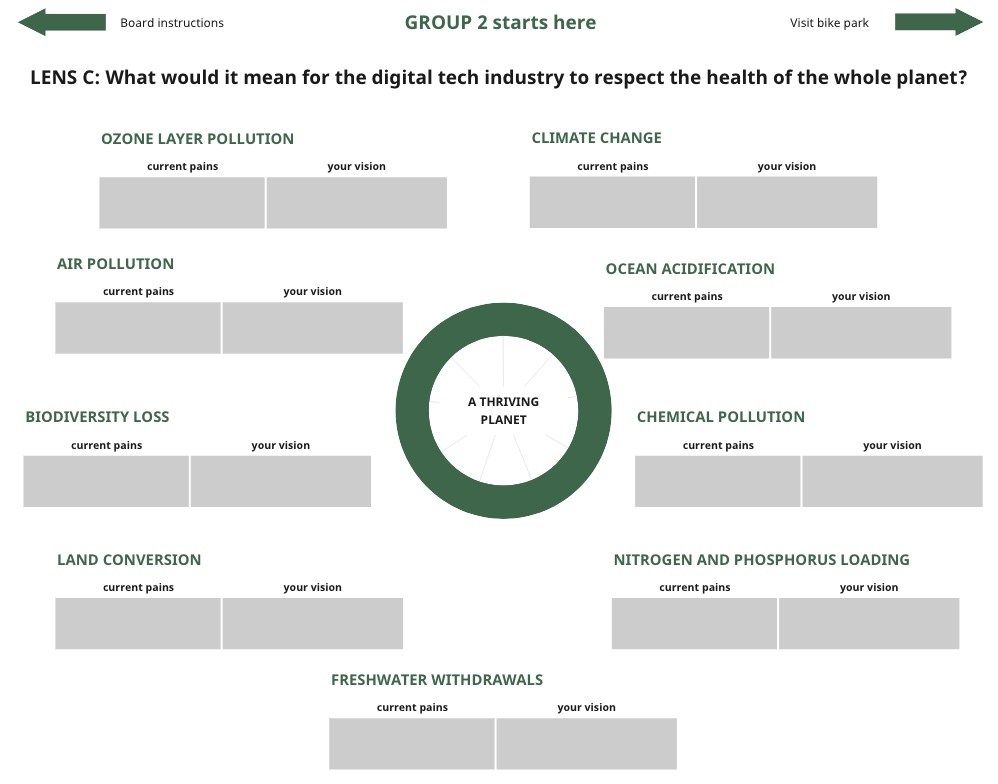
The workshops went well. They honestly weren’t without a few teething problems, but by the third run I’d ironed out the technical issues and the session ran well. People generally seemed to enjoy the format, the conversation flowed and my instinct was that most people has taken away some fresh insights. So phew! 😊
The findings
On to digesting all this info. This is where I want to give Alistair a huge amount of credit, as frankly without his help I think I would have felt quite overwhelmed on how to make sense of it all. He was invaluable.
We took all the data, placed it into various spreadsheets and started to see what patterns emerged from across the three workshops. There was so much gold in there. We made a sanitized list of all the pain point comments made during our workshops.
This is when we decided, this just can’t be buried inside a pdf report.
There’s too much. Let’s make this as transparent as possible. So I registered the URL DoingTheDoughnut.tech and set about creating a simple WordPress site (my day job is a WordPress developer afterall!). The format took a lot of inspiration from the Framing Climate Justice website, which I think does an incredible job of summarising very complex findings.
You can visit the resulting DoingTheDoughnut.tech website yourself.
But as you’re here, let me share with you a few of the key things that we found.
Did the approach work?
YES! After hosting these workshops, we felt that the Doughnut provides a friendly, accessible – and non-ideological – way of encouraging people to address fundamental and possibly radical concepts of sustainability, for example challenging economic growth, consumption and waste.
Taking action to shift the status-quo
Our workshop attendees were prompted to discuss a vision for the future for each of the 21 dimensions. In this regard, the discussions between the attendees questioned many of the fundamentals of tech industry business models.
These are the four common tech strategies that our attendees highlighted as needing to shift if the digital tech industry is to become more sustainable:
- Stop the relentless consumption/depletion of resources – attention based revenue is driving the wrong behaviours.
- Pointless – and endless – growth is getting us nowhere – the exponential growth bubble needs to burst.
- Build things that last and can be reused – the strategy of planned obsolescence only serves shareholders and not society.
- Detoxify tech culture – replace with fairness, inclusion and better ways of working.
The doughnut flower
The digital tech industry doughnut flower diagram is a visual representation of the conversation amongst our attendees from the pilot workshops. It draws inspiration from the well-known Doughnut Economics approach of quantifying the doughnut.
The outer petals represent the ecological boundaries. The darker the shade of green the more this came up as a pain point during the discussion. The inner stamens represent the social foundations and the longer and darker the stamen the more this issue featured in the workshop discussions.
Ecological ceilings discussion
The diagram helps us see that, not surprisingly, climate change was a very strong topic of discussion amongst the ecological boundaries. There was much discussion, and main examples of adverse affects relating to climate change.
Air pollution and land conversion were the next dimensions to receive the most attention.
Biodiversity loss, freshwater withdrawals and chemical pollution were discussed to some degree in most of the workshops.
Ozone depletion, ocean acidification and nitrogen/phosphorus loading were barely discussed at all, and attendees generally did not see much or any connection between these boundaries and the impacts of digital tech.
Social foundation discussion
The diagram helps us see that all social foundation dimensions were relevant to the attendees.
Most relevant, and most strongly discussed, were income and work, networks, peace and justice, and social equity.
Strongly discussed but less so were the dimensions of education, energy, gender equality, health and polictical voice.
Also discussed, but not to the same degree were food, housing and water.
Signing off from the fellowship
And so there you have it. A blow by blow account of my fellowship project, and the story of how DoingTheDoughnut.tech came to be. I feel there is huge potential in these concepts so I hope to find ways to continue to expand and elaborate upon this work.
In the meantime, this brings my fellowship journey to a close.
I feel so much gratitude for this experience and looking back at my first post I realise how much I have learned. Thank you so much to Chris Adams and Michelle Thorne for their patient and supportive guidance throughout. To my other fellows, Fieke Jansen, Melissa Hsiung, Emilio Velis and Slammer Mustata for the opportunity to learn and share alongside you, I have so much admiration for everything you do.
To Alistair Alexander for agreeing to run these workshops with me, and for sticking with me throughout the write up process. And of course, the incredible 29 people who agreed to spend two and half hours in a workshop exploring this stuff. Thank you 🙏
Workshop 1
Workshop 2
PS. I think you might see me around the Green Web Foundation a bit more now, as I’ve taken on a role as Operations and Training Manager. But I won’t be starting any more of my posts with “dear diary” from now on! 🙊

